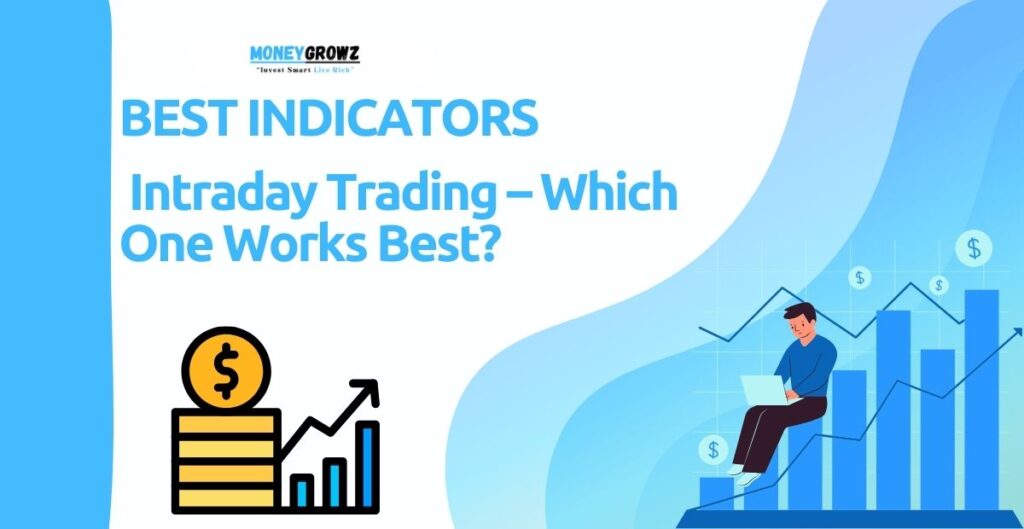Intraday trading requires quick decision-making, precise analysis, and a solid strategy. To gain an edge, traders use technical indicators that help them analyze market trends and identify potential entry and exit points. With so many indicators available, choosing the right one can be overwhelming. This blog will explore the most effective intraday trading indicators and explain how to use them effectively.
1. Moving Averages (MA) – Best for Identifying Trends
Moving Averages (MA) are essential indicators for intraday traders as they help determine the overall direction of a stock’s price movement. The two types are the Simple Moving Average (SMA) and the Exponential Moving Average (EMA). SMA calculates the average price over a specified period, while EMA gives more importance to recent price movements, making it more responsive to price fluctuations.
For intraday trading, shorter timeframes such as the 9-period and 21-period EMA are preferred. When the price of a stock moves above the 50-day EMA, it indicates an uptrend, suggesting a buying opportunity. Conversely, if the price falls below the 50-day EMA, it signals a downtrend, making it a potential selling opportunity. Traders also look for a crossover of moving averages, where the short-term EMA crosses above the long-term EMA, signaling a bullish trend, while a crossover below indicates a bearish trend.
For more details on intraday trading, click here
2. Relative Strength Index (RSI) – Best for Identifying Overbought and Oversold Levels
The Relative Strength Index (RSI) is a momentum indicator that measures the speed and change of price movements. It ranges from 0 to 100 and helps traders identify whether a stock is overbought or oversold. When RSI crosses above 70, it indicates that the stock is overbought and may experience a price correction. On the other hand, when RSI falls below 30, it suggests that the stock is oversold and could potentially rise.
Apart from the overbought and oversold levels, traders also use RSI divergences to predict trend reversals. If the stock price is making higher highs while RSI is making lower highs, it indicates a potential reversal to the downside. Similarly, if the price is making lower lows while RSI is making higher lows, it suggests an upward reversal. For intraday trading, a 14-period RSI with a 5-minute or 15-minute chart is commonly used.
3. Bollinger Bands – Best for Measuring Market Volatility
Bollinger Bands consist of three lines: a middle moving average and two outer bands that are placed at standard deviations from the middle line. These bands expand when the market is volatile and contract when the market is stable. Bollinger Bands help traders identify potential breakouts, price reversals, and volatility levels.
When the price touches the upper band, it indicates that the stock is overbought and may experience a pullback. Conversely, when the price reaches the lower band, it signals that the stock is oversold and could bounce back. A Bollinger Band squeeze occurs when the bands contract, signaling a period of low volatility. This often precedes a significant breakout, making it a crucial signal for traders. A 20-period Bollinger Band with a 5-minute chart is ideal for intraday trading.
4. Moving Average Convergence Divergence (MACD) – Best for Identifying Trend Reversals
MACD is a trend-following indicator that consists of two moving averages: the MACD line and the signal line. It also includes a histogram that represents the difference between these two lines. When the MACD line crosses above the signal line, it indicates a bullish trend, while a crossover below the signal line suggests a bearish trend.
A shrinking histogram moving toward the zero line signals that a trend reversal might occur soon. Traders use MACD to confirm trends and identify potential reversals before entering or exiting trades. The best settings for intraday trading are a 12, 26, and 9-period MACD on a 15-minute chart.
5. Volume Weighted Average Price (VWAP) – Best for Identifying Institutional Buying/Selling
VWAP is a powerful indicator that calculates the average price a stock has traded at throughout the day, considering both price and volume. It is often used by institutional traders to determine whether a stock is trading at a fair price.
When the price is above the VWAP line, it indicates bullish momentum, and when the price is below the VWAP line, it suggests bearish momentum. Many traders use VWAP as a support and resistance level. If the price pulls back to VWAP and bounces upward, it can be considered a strong buy signal. Similarly, if the price rises to VWAP and gets rejected, it can be a good short-selling opportunity. For intraday trading, the best timeframe for VWAP is a 1-minute or 5-minute chart.
6. Stochastic Oscillator – Best for Confirming Reversals
The Stochastic Oscillator is another momentum indicator that helps traders identify overbought and oversold conditions. It ranges from 0 to 100, with values above 80 indicating overbought conditions and values below 20 indicating oversold conditions.
Traders also look at the %K and %D lines of the Stochastic Oscillator to identify crossovers. A bullish crossover occurs when the %K line crosses above the %D line, signaling a potential upward move. Conversely, a bearish crossover occurs when the %K line crosses below the %D line, signaling a downward move. This indicator is commonly used in combination with other indicators for confirmation. The best setting for intraday trading is a 14, 3, 3 Stochastic Oscillator on a 5-minute chart.
7. Fibonacci Retracement – Best for Finding Support and Resistance Levels
Fibonacci Retracement is a popular tool used to identify potential support and resistance levels. It is based on the Fibonacci sequence and consists of key levels such as 23.6%, 38.2%, 50%, and 61.8%. These levels act as strong areas where the price may either reverse or continue its trend.
If the stock price pulls back to a Fibonacci level and finds support, traders consider it a buying opportunity. Conversely, if the price rises to a Fibonacci level and gets rejected, it acts as resistance, making it a potential shorting opportunity. This tool is widely used along with other indicators for higher accuracy. A 5-minute or 15-minute chart is best suited for Fibonacci retracement in intraday trading.
Which Indicator Works Best?
There is no single best indicator for intraday trading. The most successful traders combine multiple indicators to confirm trade signals and improve accuracy.
One of the best combinations for intraday trading is the EMA + RSI strategy, where traders use the EMA to determine the trend and RSI to confirm overbought or oversold conditions. Another effective combination is Bollinger Bands + MACD, which helps identify breakouts and momentum shifts. Additionally, VWAP + Fibonacci Retracement can be used to find strong entry and exit points.
TradingView is a great tool for intraday trading analysis. It provides real-time charts, customizable indicators, and drawing tools to help traders make informed decisions.
Conclusion
Intraday trading requires precision, quick decision-making, and a solid risk management plan. While technical indicators help in identifying trends, reversals, and key levels, traders should always back-test their strategies and use stop-loss orders to minimize risks.
Understanding how different indicators work and combining them effectively can significantly improve your intraday trading success. Experiment with these indicators, analyze their performance, and refine your strategy to maximize profitability.
Which indicator do you find most effective for intraday trading? Share your thoughts in the comments below!




I found your weblog web site on google and examine a few of your early posts. Continue to keep up the superb operate. I just extra up your RSS feed to my MSN News Reader. Seeking forward to studying more from you in a while!…
I was wondering if you ever considered changing the structure of your website? Its very well written; I love what youve got to say. But maybe you could a little more in the way of content so people could connect with it better. Youve got an awful lot of text for only having one or 2 images. Maybe you could space it out better?
Spot on with this write-up, I really believe this site needs much more attention. I’ll probably be returning to read through more, thanks for the info!
I’m not sure if this is a format issue or something to do with internet browser compatibility but I figured I’d post to let you know. The style and design look great though! Hope you get the issue fixed soon. Many thanks
I do trust all of the ideas you have presented on your post. They are really convincing and can certainly work. Nonetheless, the posts are too brief for newbies. May just you please lengthen them a bit from subsequent time? Thanks for the post.
Well I truly enjoyed reading it. This tip provided by you is very helpful for good planning.
https://stream2watch.ink
Great site wow